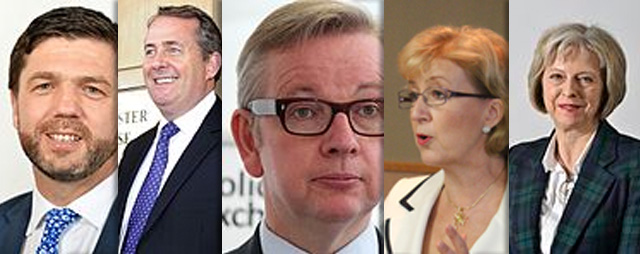
On Thursday at midday nominations closed for the Conservative Party leadership contest. It’s been a week of high drama in politics – and many of you will have your views on the candidates (and those who aren’t candidates) – but how do Conservative Party leadership elections work?
Unlike Labour leader contenders, who need 15% of the Parliamentary Labour Party, in the Conservatives candidates need only be nominated by a proposer and a seconder. These nominations are public. (ConservativeHome and Guido Fawkes are publishing up-to-date online lists of who the candidates’ supporters are amongst other MPs.) This time ‘round, five candidates were duly nominated before the deadline, Stephen Crabb, Liam Fox, Michael Gove, Andrea Leadsome and Theresa May.
According to the timetable outlined by the 1922 Committee (the Conservative backbench committee), Tory MPs will vote this evening for which candidate they would most like to be leader. The candidate with the fewest votes will be eliminated. They are then free – if they so wish – to urge their supporters to back another candidate. On Thursday, the process is repeated with the remaining four.
Penultimately, on Tuesday 12th July, Conservative MPs will vote amongst themselves for the last time. The two candidates with the highest vote will then be featured on a ballot paper to be printed and posted to roughly 130,000 Conservative Party members. The likely deadline for this is 8th September, with the results, and hence the new prime minister, announced the following day – leaving a little under two months for the top two to set out their case to party members and the public.
The system is ripe for intrigue and tactical voting. Given the two electorates, Conservative Party MPs may feel inclined to attempt to shape the members’ ballot on the basis of how they expect members to react to the two candidates on the ballot. For instance, in 2001, there is evidence that supporters of Iain Duncan Smith tactically voted for Ken Clarke in order to knock Michael Portillo off the ballot, feeling (rightly) that the members would reject Clarke’s Europhile views. MPs could also pretend to support a candidate to generate a false sense of security and encourage their supporters to misjudge their tactical votes. This is perhaps a disadvantage when compared to a system where rankings occur on a single ballot, as in the Alternative Vote system, where voters have less chance to mull on the results of each round and predict which way their colleagues votes will split.
Although it features different electorates, the electoral system is a little like France’s two-round system combined with the Alternative Vote. (The Conservatives use a similar system when selecting candidates.) Moderately humorous, considering most Conservatives were so vociferously opposed to AV (a system which would have seen our majority increase by eight in 2015!).
Anthony Tuffin says:
That is an excellent explanation of the system and a good example of how preferential voting such as AV would be an improvement, without changing the basic concept that the two eventual candidates, between them, enjoy widespread support of Conservative MPs.
Another advantage of preferential voting is speed. Many have criticised the Conservative Party for keeping the nation waiting at this crucial time while the party chooses its new leader and the next PM. On the other hand, it is fully understandable that David Cameron resigned and the party wants to choose its next leader democratically and with due process.
Unfortunately, the process being used is slow. With AV, the result would have been at least as democratic and known today.